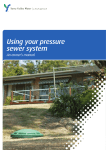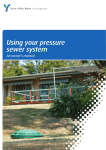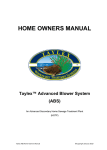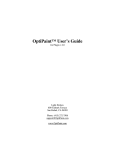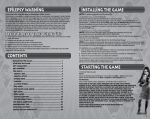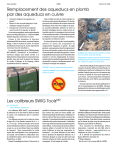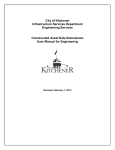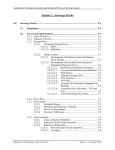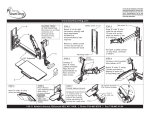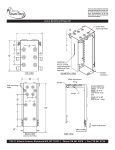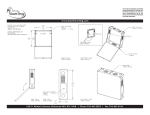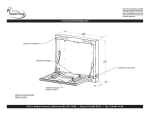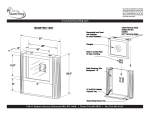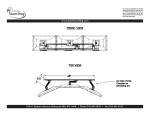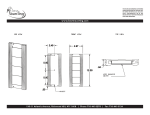Download Richmond Valley Home Owners Manual
Transcript
Broadwater Sewerage Scheme Home Owner’s Pressure Sewer Manual October 2012 It is strongly recommended that you read this manual and thereafter keep it in a safe, but readily accessible place. You should re-familiarise yourself with it each year. If the property is rented then the manual should be provided to the tenant along with instructions for them to familiarise themselves with the document. Additional copies of the Manual are available from Richmond Valley Council. Index Page 1.0 YOUR PRESSURE SEWERAGE SYSTEM 2 2.0 MAINTENANCE OF THE SYSTEM 2 3.0 WHAT IS EXPECTED OF THE PROPERTY RESIDENT 2 3.1 What Should Not be Discharged into the Sewerage System 3 3.2 What the Resident Needs to Know if the Pump Breaks Down 3 3.3 Going on Holidays 3 4.0 WHAT IS EXPECTED OF THE PROPERTY OWNERS 4 5.0 WHAT TO DO IF AN ALARM SOUNDS 4 5.1 Step 1 – Turn off the Audible alarm 4 5.2 Step 2 – Determine if there has been a Power Blackout 4 5.3 Step 3 – Report the Alarm to Richmond Valley Council 4 5.4 Step 4 – Agree with Richmond Valley Council when Repairs are to be Carried Out 5 5.5 Step 5 – Minimise Wastewater Generation Until Unit is Repaired 5 5.6 Step 6 – Ensure the Richmond Valley Council Repair Officers have Access to the Pumping Station 5 5.7 Step 7 – Confirm the Pumping Unit is repaired before Reverting to Normal Operation 6 6.0 WHAT TO DO IF THE DISCHARGE PIPELINE BREAKS 6 7.0 RICHMOND VALLEY COUNCIL ACCESS TO THE PRESSURE SYSTEM 7 8.0 RICHMOND VALLEY COUNCIL NOT LIABLE 7 The Contact Numbers for Richmond Valley Council’s Emergency Services are: Time Contact No Monday to Friday (02) 666 00 300 8.00 am – 4.30 pm Outside Business Hours Home Owner’s Pressure Sewer Manual (02) 666 00 300 Page No 1 1.0 YOUR PRESSURE SEWERAGE SYSTEM Richmond Valley Council would like to welcome you to Pressure Sewerage Services. Your property’s sewerage service is provided by what is known as a pressure sewerage system, whereby a pumping unit installed on your property pumps the property’s sewage through a street reticulation system that eventually joins to the Evans Head Sewage Treatment Plant (STP). Whilst this system is different to more conventional sewerage systems, it effectively requires little more thought or effort on the part of the resident than for a more conventional sewer system. The exception to this is that these systems have a visual and audible alarm to warn you if something has gone wrong with the unit. Should this occur (and this should be very infrequently) then the resident is required to contact Richmond Valley Council at the contact numbers provided in Section 5 and follow the steps laid out in that section. One advantage of these systems is that even if the alarm does sound, it does not mean that you cannot use your system as there is an emergency storage volume in the unit to cater for such breakdowns and any power outages that may be experienced (refer Section 5). These systems are not inferior to more conventional sewerage systems and this technology was selected for your area as it represented the best overall solution. These systems are still relatively new to Australia but have successfully been in operation for around 30 years overseas. This experience has indicated that these systems require little maintenance. If you require more details on these systems then go to Council’s website (www.richmondvalley.nsw.gov.au). This manual has been put together to assist you on how to operate your pressure sewerage system and what to do if things go wrong with it such as the alarm sounding. 2.0 MAINTENANCE OF THE SYSTEM Richmond Valley Council is maintaining the pressure sewerage system on your behalf including your pumping unit and the line connecting it to the boundary valve kit (as well as the boundary kit). All of these elements are the property of Richmond Valley Council. The house sewer drainage that discharges into the pumping unit is the property owner’s responsibility. Richmond Valley Council will only come onto the property in response to a call from the resident, as there should be no preventative maintenance on the pumping units. The normal method of repair will be to replace the existing pump with a spare pump and then take the defective pump back to the workshop for repairs. The repaired pump will then be placed in the pool of spare pumps for use when required and thus there will be no need to return to your property. 3.0 WHAT IS EXPECTED OF THE PROPERTY RESIDENT The resident is expected to carry out the following in relation to the operation of the pressure sewerage system. - Contact Richmond Valley Council if the alarm sounds and follow the steps laid out in Section 5.0. - Do not discharge into the sewerage system any of the substances set out in Section 3.1 below. These substances should not be discharged into any sewerage system. - Make sure that the household drains are appropriately maintained and no stormwater is allowed into the pressure sewerage system. - Make sure the venting into the pumping unit remains clear at all times, so that it can function properly. - Do not touch the valves in the Boundary Kit (The box at the edge of the property as this is Richmond Valley Council property). - Familiarise yourself with the location of the property delivery line, and avoid damaging the pipeline and pumping unit. - The unit is to be connected to the property’s power board but will be on its own circuit. The resident will be responsible for meeting the power costs and the pump is not separately metered. Home Owner’s Pressure Sewer Manual Page No 2 Do not go into the pumping unit or even take the lid off. The inside of the pumping unit represents a confined space working environment that could be dangerous, without the appropriate training and equipment. 3.1 What Should Not be Discharged into the Sewerage System The following substances should not be discharged into your pressure sewerage system, to avoid blockages or damage to the pump and/or grinder unit contained in the pumping unit: - Glass - Kitty Litter - Metal - Explosives - Gravel/Sand etc - Flammable Materials - Seafood Shells - Lubricating Oil and/or Grease - Goldfish Stone (Aquarium Gravel) - Strong Chemicals - Diapers, Socks, Rags or Clothes - Gasoline - Plastic Objects - Diesoline - Sanitary Napkins or Tampons 3.2 What the Resident Needs to Know if the Pump Breaks Down If the system breaks down, the alarm will sound to warn you that the system is not working. When this occurs you should follow the steps set out in Section 5 of this Manual. However the resident needs to be aware of the following when this occurs: - The sounding of this alarm does not mean that you can no longer use your sewerage system. The pumping unit still has in excess of 400 litres of storage when the alarm sounds. Use of this emergency storage is one of the main advantages to pressure sewerage systems over other sewerage systems but some precautions must be adopted in using this storage. - There is no specific cost for normal repairs carried out by Richmond Valley Council, as these are covered in your sewerage rates. However Richmond Valley Council may charge for damage done to the pipeline or pumping unit from abnormal behaviour. - If the breakdown occurs after normal business hours, the repairs will normally be carried out the next morning as the pressure system has this emergency storage capability. However you should report it immediately. - You do not have to be there for repairs to be carried out on the unit if you have followed the rules in respect to Richmond Valley Council access, with the exception of secured backyards. 3.3 Going on Holidays When going on holidays, (and there is no one at home) then the pumping unit needs to be flushed out before leaving to avoid any potential for odour generation. The resident should: i. Run clean water into the pumping unit until the pump activates and runs for about 30 seconds. Half filling the bathtub and discharging it will achieve such a flush. ii. Do not turn off the power to the pumping unit if you are turning off the power to the rest of the house. This is in case there are any leaking taps which might fill the storage vessel. If the resident fails to clean their systems, before going on holidays and Richmond Valley Council has to flush the units in response to complaints from surrounding neighbours, it may choose to invoice the resident for the costs to carry out that work. Home Owner’s Pressure Sewer Manual Page No 3 4.0 WHAT IS EXPECTED OF THE PROPERTY OWNERS In some instances the property owner will be different to the resident. Where this is the case then the property owner will be required to ensure the following: − A copy of the Home Owner’s Manual is to be provided to the residents. − Payment of the annual sewerage charges. − Ensuring no roof or other stormwater is connected to the pumping unit. 5.0 WHAT TO DO IF AN ALARM SOUNDS When an alarm sounds the resident should respond by following the simple steps set out below: 5.1 Step 1 – Turn off the Audible alarm Alarm Light Alarm Panel Button to silence the audible alarm Figure 5.1 Location of Audible Alarm Silencing Switch The audible alarm can be turned off by pressing the button on the underside of the alarm panel, refer to figure 5.1. This panel will be mounted on the wall of the house, shed, and garage or on a stand alone post, if located away from the home. The alarm light cannot be turned off. It will turn itself off when the repairs are completed and the pumping unit is operating normally. 5.2 Step 2 – Determine if there has been a Power Blackout If the alarm sounds immediately after a major power failure wait for one hour before calling Richmond Valley Council. The alarm could in these instances sound when the power is restored, simply due to the storage that has occurred during the power outage. Therefore there could be a number of property pressure units trying to pump at the same time, but the town’s collection system will limit the number of units that can pump at the same time. The system will therefore take a short time to clear and the wait will clarify this. 5.3 Step 3 – Report the Alarm to Richmond Valley Council You should contact Richmond Valley Council at the numbers below. However before you report the alarm to Richmond Valley Council you should investigate the following: - Is there any sewerage coming from the Overflow Relief Gully. (An inspection opening in your household drainage.) - Are there any discharges coming from the ground? - Are there any perceptible odour problems? - Has there been a power failure (as per Step 2) and have you waited the suggested 1 hour before calling. - Is the pump making any unusual noises? The operator will ask you these questions, as well as the nearest cross street for reference purposes. Home Owner’s Pressure Sewer Manual Page No 4 The Contact Numbers for Richmond Valley Council’s Emergency Services are: Time Contact No Monday to Friday (02) 666 00 300 8.00 am – 4.30 pm Outside Business Hours 5.4 (02) 666 00 300 Step 4 – Agree with Richmond Valley Council when Repairs are to be Carried Out When you are speaking to the Richmond Valley Council Service Operator, you need to confirm if there is an urgent need for the repairs to be carried out. The normal method of repairs is to do these repairs the next morning, but if there is an urgent need repairs will be carried out immediately. Next day repairs are preferred for the following reasons: - To minimise the inconvenience to the residents and their neighbours, who probably don’t want to be disturbed late at night and can still use their systems. - To minimise any potential damage to the householder’s property (particularly the landscaping) as the maintenance crew will be able to better see where they are treading in the daylight hours. - It keeps overall system operational costs down by avoiding costly after hours call outs and this helps Richmond Valley Council to keep sewerage rates lower. 5.5 Step 5 – Minimise Wastewater Generation until Unit is Repaired In the period between when the alarm sounds and when it is repaired, you should minimise the overall volumes of wastewater being generated. This can be done in the following manner: - Do not turn on any clothes washing machines or automatic dishwashers whilst the alarm is active. - Keep showers very brief. - Where the resident takes a bath, leave the plug in until after the alarm has been cancelled or bucket out the water onto the lawn. - Switch off any drainage (automated or not) from swimming pools, spa’s, etc until after the unit has been repaired. - Practice good water savings techniques such as not leaving taps running etc. 5.6 Step 6 – Ensure the Richmond Valley Council Maintenance Crew have Access to the Pumping Unit Ensure the Richmond Valley Council maintenance crew have access to the pumping unit. They might also need to carry the pump on a trolley to their truck and therefore a clear pathway will be required. The following actions should be taken: - Ensure that any property gates are unlocked. - Ensure that the driveway or pathway leading to these gates is clear to allow access. - Lock up any pets that might escape the property. - Ensure the lid of the pumping unit is clear of any mulch, pot plants etc, and clearly visible. - Landscaping that can be removed from around the pumping unit, if possible should be removed. - Ensure obstacles in the yard that might prohibit the trolley from gaining access to the pumping unit are cleared away and you have a preferred pathway for the unit. Home Owner’s Pressure Sewer Manual Page No 5 5.7 Step 7 – Confirm the Pumping Unit is repaired before Reverting to Normal Operation The Council Officer will inform the resident before leaving the site that all repairs have been carried out. If you have been away from the property during the repairs, you need to check that the repairs have been completed before returning to normal operating. This can be determined by the alarm light no longer being illuminated. 6.0 WHAT TO DO IF THE DISCHARGE PIPELINE BREAKS The pipeline in the property from the pumping unit to Richmond Valley Council’s sewerage reticulation mains is: - Polyethylene Class 16 (flexible) Black in Colour with a cream stripe (or straight black) Buried at a depth of around 450mm Under Pressure Being a sealed pipe system there are no (or few) joints that might allow tree root ingress, nor should the pipeline break as a result of ground movement. The most likely cause of pipebreaks will be others digging near the pipeline and accidentally striking the main. Therefore always ensure you are aware of where the pipe is before commencing any digging, and in the unlikely event that this line should break it will behave more like a broken water main. If this occurs then you should take the following steps. Step 1 Try and determine if the broken pipe is a watermain or a sewer main. Guides as to whether the broken pipe is a sewer main are: - Smell - Colour of the pipe - Location of the main (Is it where you expected the sewer main to be) - Pulsing of flows, as the sewage is pumped through the system. A water main will flow fairly constantly until isolated. - If the above are inconclusive turn off the pump (see Step 2 below) and see if this stops the leak. Step 2 If you believe it is a broken sewer pipeline, turn off the power to the pumps in the household switchboard. These pumps have a separate circuit and will not impact the remainder of the house, if they are turned off. Step 3 Report the broken main to Richmond Valley Council (as per section 5.3) and tell them you have switched off the pump. Step 4 Minimise the amount wastewater discharged into the sewerage system, until repairs are carried out. Step 5 Recommence normal operation, once Richmond Valley Council has concluded the repairs to the main and the alarm light has gone out. It is probably that the sewage in the pumping unit will have reached alarm levels when the repairs are affected. Home Owner’s Pressure Sewer Manual Page No 6 7.0 RICHMOND VALLEY COUNCIL ACCESS TO THE PRESSURE SYSTEM The minimal requirements for access by Richmond Valley Council maintenance crews are set out in Section 5.6. However some key aspects in respect to access that need to be noted are: 1. The pumping unit may be covered by tanbark or pot plants that can be moved by the resident when repairs are required. The unit is not to be buried, nor paved over, nor concreted over, nor permanently covered in any other manner. 2. When Richmond Valley Council staff come to repair the unit it must be uncovered and accessible. If Richmond Valley Council staff are unable to locate the unit because it has been covered, Council may refuse to carry out repairs until the owner/resident exposes the unit, and it may charge the resident a service call, even if the unit is not repaired. At a minimum Richmond Valley Council may pass on to the resident/ owner any costs for it to locate and uncover the pumping unit, and it may choose to impose fines for where it has been covered in a more permanent nature. 3. If pets are not secured Richmond Valley Council staff may refuse to enter the property and carry out any repair works where they cannot contact the resident to secure the pets. In these instances Richmond Valley Council will not be held liable for any repairs not being carried out in a timely manner and it may elect to send a service call invoice to the resident. 4. Access through any gates to the pumping unit for a trolley device will be required. Maintenance Staff will need to place a lifting frame above the pumping station to lift out the pump and then carry the pump away to their vehicle, and thus they need a path for the trolley. Any resident that closes off this access way will be responsible for any additional costs incurred and if additional equipment, such as cranes etc are required. Richmond Valley Council will not be held to next day responses in these instances. 5. Any residents with secured properties must be present to allow the Richmond Valley Council staff access to the yard at the agreed time, based upon arrangements made when the resident calls to notify Richmond Valley Council of the system failure. 8.0 RICHMOND VALLEY COUNCIL NOT LIABLE Richmond Valley Council will not be held liable for any overflows that may occur on the property where the resident has failed to notify Richmond Valley Council of any system breakdowns. Residents will be liable for any overflows that happen off their property and may be prosecuted for environmental breeches if they have failed to appropriately notify Richmond Valley Council. A record of all notifications will be maintained by Richmond Valley Council. Home Owner’s Pressure Sewer Manual Page No 7








